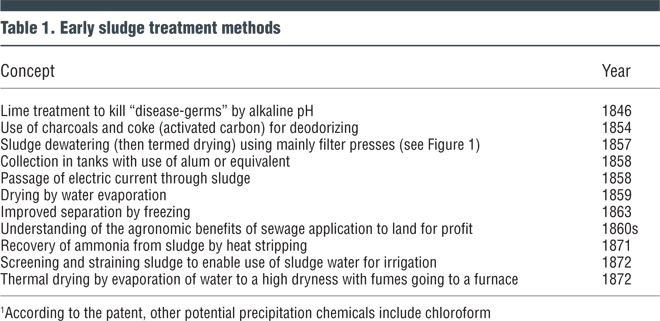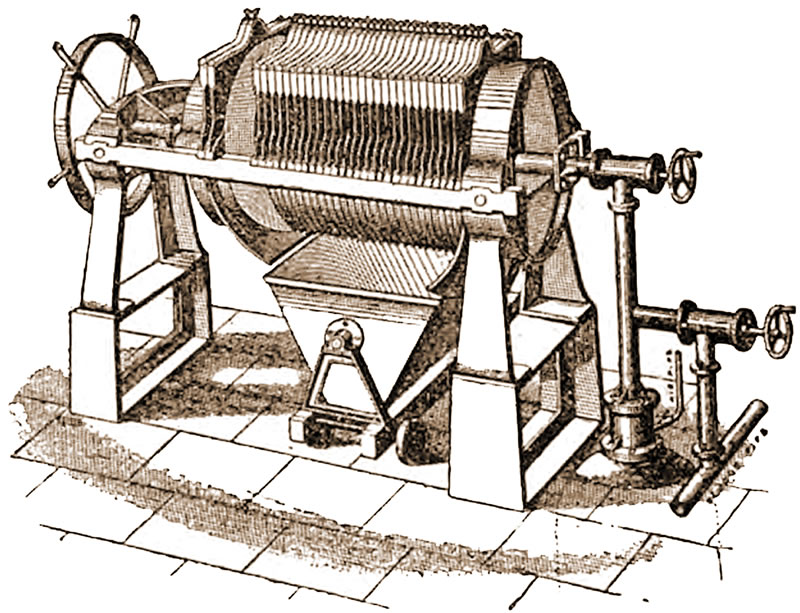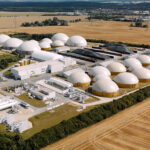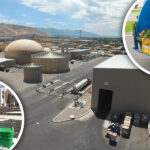The origins of today’s wastewater treatment and anaerobic digestion technologies hark back nearly 175 years.
Bill Barber
BioCycle October 2015
Be it known that I, Karl Imhoff, a subject of the German Emperor, residing at Bredeney, near Essen, in Germany, have invented a certain new and useful improvement in treating sewage.” Imhoff’s invention, according to his 1910 patent filing, “relates to the method of sewage treatment in which sedimentation takes place in successive chambers. It also relates to that method of sewage treatment which consists in spreading the sewage on bacteria beds, with mechanical purifying sedimentation preceding and succeeding the treatment on the beds.” A great deal has changed, both globally and in the world of sewage treatment since Karl Imhoff patented his invention in 1910. The benefits of storing sewage in a tank to reduce its putridity and quantity had been noted in the years preceding Imhoff’s invention, although the concepts for the need of sewage treatment date back to a report by Sir E. Chadwick, “Health of the Working Classes,” published in 1842.
However, it was a severe cholera epidemic that incentivized the British Parliament to pass the Nuisance Removal Act in 1855, which launched the scientific study of the chemistry and biology of sewage sludge. The first forms of sludge treatment were straightforward collection and diversion to the nearest watercourse rather than allowing it to accumulate near dwellings. It wasn’t until 1857 that it was a legal requirement to remove suspended matter or “deodorize” sewage prior to its “admission to the streams.” The United Kingdom in the mid-19th century was undergoing unprecedented technological development, and the waste materials from the industries that fueled this development also found their way into the water system. According to textbooks written at the time, sewage sludge would contain wastes from tanneries, wool mills, dye works and paper works, as well as coal ashes, slag, solid refuse from earthenware manufacturers and metal works, soil, stones, clay from quarries and mines, road grit and filth from the streets, and last but not least, a variety of animal carcasses.
When sewage sludge was passed into comparatively small rivers from high population density areas, it caused severe pollution — so much so, that the varied industries of the Victorian era blamed the sewage for spoiling their water supply. Not surprisingly, the original drivers for sewage treatment were to reduce river pollution. An Act of 1861 was passed that required sewage be purified and freed from faecal and other putrescible matters prior to stream and river discharge.
Sewage Disinfection
Until 1893, the disinfection of sewage was regarded as a comparatively simple and inexpensive problem. It was thought that the addition of lime, until the sewage became slightly alkaline, was sufficient to kill any typhoid or cholera bacilli that might be present. However, varied and inconsistent results led to development of further technologies, principal of which was the septic tank (precursor of Imhoff’s invention of 1910) as it was discovered that storage of septic sludge under anaerobic conditions reduced both the numbers of disease causing organisms and the sludge itself. It was understood that the offgas contained methane and carbon dioxide, as shown in the following equation, based on the understanding of the time:
4 C8H13N2O3 + 14 H2O = 4 N2 + 19 CH4 + 13 CO2 + 2 H2
However, the gas itself would not be intentionally exploited for nearly a hundred years.
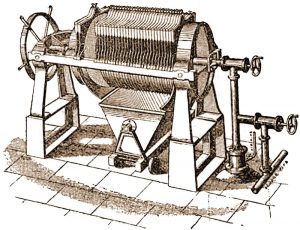
Figure 1. Plate press dewatering device from the 1860s. Sludge then had low volatile solids content, subsequently typical output was in the range of 50% dry solids
and above.
Other than lime, a plethora of other chemicals were added to treat sludge with early sludge engineers akin to medical apothecaries. Some of the more exotic materials added included: sawdust moistened with sulphuric acid (to aid dewatering), turpentine, iron filings, brick dust, oil tar, hydrochloric acid gas, tanners’s spent bark, animal charcoal, salt, sugar, urine, carbolic acid, phosphoric acid, “soft-sludge” from alum works, numerous metallic salts, blood and so forth. One patent that catches the eye is No. 3,566, filed in 1867 by A. M. Clark, which “treats sewage with neutral phosphate of magnesia, in order to precipitate ammoniaco-magnesian phosphate.” In modern language, this is the intentional production of struvite from sewage sludge, a practice gaining ground at full-scale in the 21st century. Interestingly, viewing patent archives reveals that many of today’s technologies and ideas are, if not variations of, almost identical to ideas from before the turn of the 20th century. Some of these are shown in Table 1. An illustration of sludge dewatering is in Figure 1.
Origins Of Advanced Digestion
Although the offgas from septic tanks was not predictable in terms of quality, patents started appearing for advanced digestion systems. Andrew Provost had a patent granted for an advanced staged anaerobic digester made of internal compartments in order to improve bacteriological activity and help maintain solids within it (Figure 2). The standard design of anaerobic digestion facilities at municipal plants even today still does not allow for enhanced solids retention. Provost’s patent was granted in 1902.
If we fast forward to what wastewater treatment looks like today, we see it comprises of technologies from different epochs, from the late 1800s (preliminary and primary treatment, use of lime and other admixtures, dewatering, drying), Edwardian era (activated sludge, anaerobic digestion as mainstream process) and much later in the 1970s (acid-phase and thermal hydrolysis prior to anaerobic digestion). When going through archives, it is clear that other technologies such as gasification, pyrolysis and wet air oxidation, also find their origins several decades into the past. With this in mind, many of the commercially available technologies of the future may already be amongst us, albeit most probably at laboratory or pilot-scale.
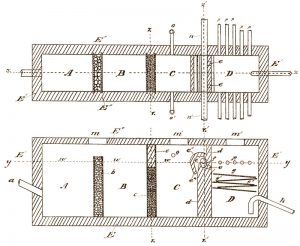
Figure 2. Apparatus for the (anaerobic) treatment of sewage. Extracted from U.S. Patent No. 699,345. (May, 1902)
Thermal hydrolysis prior to anaerobic digestion is now considered best practice in the United Kingdom, but its origins go back to laboratory trials in Stanford over 30 years earlier. Likewise, biological or two staged digestion, also commonly employed today (especially in the U.S.), was patented in the 1970s. While it is difficult to predict which current embryonic technologies will flourish in the future, it is clear that sewage sludge treatment of tomorrow will have to accommodate fundamental change at a global level.
What we do know is that the global population is both growing and mobilizing into urban environments. In 20 years’ time, there will be over a billion additional people inhabiting the planet, and in Asia, over half the population will be living in megacities. This increased population will also be wealthier and consume more and varied materials. In China, eating habits are already changing to a more meat, rather than vegetable, centered diet. Meat based diets need approximately three times the nutrients and many times the water consumption of their meat-free alternatives to be sustained. In addition, the influence of climate change will become more prevalent.
These factors will increase pressure on the world’s power, food and water demands. Subsequently, treatment plants of the future will need to adapt to help meet these needs. The type and quantity of sewage sludge produced and ultimately treated will change, as it has since the days of the industrial revolution. The characteristics of sludge are influenced by numerous parameters such as: wastewater regulations; eating habits, water use; environmental parameters, such as precipitation and temperature; changes in type and quantity of industry, recycling habits and so forth. Volatile solids content in UK sludge is now over 50 percent higher than it was in the late 1800s, and as we have seen, processing has become increasingly more difficult. In context, some parts of the world still suffer the largely preventable health issues faced by Victorian Britain, where protection of river systems from raw sewage and industrial discharge is paramount to improve health.
Bill Barber is a Technical Director within AECOM’s water sector, with a focus on biosolids treatment and processes. He will deliver a keynote presentation on what sewage sludge treatment will look like 20 years from now at the 20th anniversary of Aqua Enviro’s European Biosolids and Organic Resources Conference & Exhibition, November 9-11, 2015, Manchester Town Hall, UK. http://www.european-biosolids.com/
